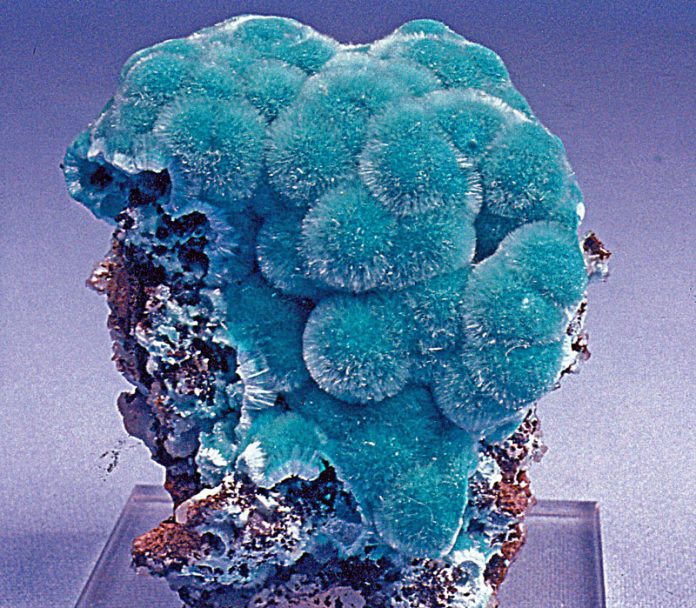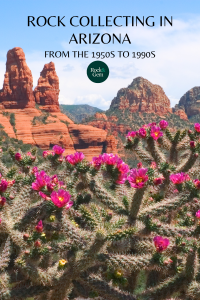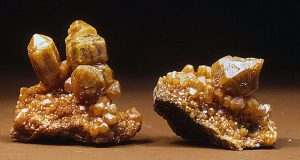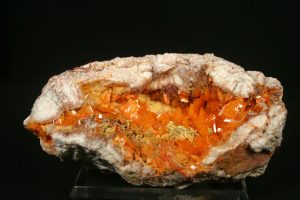
Rock collecting in Arizona can be a paradise for mineral collectors. When I moved to Arizona in the late 1950s, I was astonished by the many choices I had to collect underground and the quantities of specimens often found. Many times, I counted my finds by the number of flats I filled. The beauty of this was it gave me lots of choices and plenty of trading material.
From the 1950s to the 1990s, collecting in Arizona was a bonanza of finds. Many locations yielded amazing quantities of world-class specimens. This changed Arizona from being wide open to claimed or managed specimen mining projects as values increased.
The Red Cloud Mine

The Red Cloud mine is a superb example of rock collecting in Arizona. In the halcyon days, we could go to a club meeting on Friday night then camp overnight and spend Saturday collecting wulfenite. It was not unusual to climb down to the 500-foot level to collect.
What might be called freelance collecting at the Red Cloud and other mines slowed in the 1990s as mineral values rose and collectors gained control of a mine. One group formed a company and developed an open pit at the Red Cloud. They hit a bonanza, a nearly vertical seam extending deep into the deposit. The walls of this opening were completely lined with bright red crystals. Weeks of mining produced a huge quantity of specimens ranging in size from thumbnails to plates a foot or more across. All were covered with crystals. These crystals tended to average an inch or more on an edge and clusters of free-standing crystals completely covered the matrix. Their color ranged from good red to brilliant vibrant red. Once this highly productive vein was mined out, the operators were generous in allowing organized clubs opportunities to surface collect.
Copper Mines
Copper mines have always been a good source for rock collecting in Arizona. Bisbee in particular is well known for minerals. This is because Phelps Dodge, who operated the Copper Queen Mine allowed miners to collect as long as they did their assigned tasks. The Morenci Mine, in recent decades, did agree to specimen mining under contract.

World War II Mines
The big crystal finds from rock collecting in Arizona that convinced the world that Arizona was the place to collect started in the 1950s when small meal mines were still operating after World War II. This included the Glove, Defiance, Holland, Flux, 679, Rowley, Old Yuma, and others.
The 679 mine was always a fruitful underground dig for wulfenite, aurichalcite, and smithsonite. It was always accessible, though like most properties, was owned by absent owners. Today it is claimed and being prepared as a specimen-collecting mine open only by invitation.
Close to the Mexican border is the Holland, well known for Japanese law twinned quartzes. The largest I’ve seen were found by collectors with crystals each 10 inches long. I never had any luck underground at the Holland. The host rock is mostly solid garnet and any hammer work shattered pocket contents.
The Flux Mine
The Flux is another story for rock collecting in Arizona. It was open pitted which exposed huge open veins filled with snow-white jackstraw cerussite. The veins were many inches wide and extended several feet. Collecting was just a matter of being careful not to damage the brittle jackstraw crystals.
Some of my buddies got in trouble at the Flux mine when collecting. One day some of the guys were collecting and ran out of packing paper. One of them went down the mountain to the village and bought a quantity of toilet paper for packing. It happened a sheriff was in the store and he followed the collector back to where they were collecting. He arrested them all because he thought they were cooking drugs. At the station, they cleared themselves and were let go, but the sheriff kept their specimens.

The Old Yuma
Of all the old mines in Arizona, the Old Yuma is so close to Tucson you can see the downtown area from the mine dumps. It was a fruitful producer of fine wulfenite and vanadinite. The mine is next to the Western Branch, Saguaro National Monument. The Feds were anxious to buy the mine claims and shut everything down. Dick Bideaux owned this old gold mine and named his price which the Feds would not pay. Dick then had plans made for a cyanide gold-leaching plant. The Feds settled quickly to the tune of over $600,000. The old Yuma and its fine minerals are now absolutely off-limits!
Dick Jones, a retired sheriff’s deputy, often collected the Old Yuma and he always carried his pistol with him. He was collecting there one day and stopped to have lunch. Sitting on one side of the open pit he noticed a bright yellow spot on the opposite wall of the pit. Out of curiosity he pulled his service pistol and shot at the yellow spot. To his surprise, the bullet opened up a small pocket of fine wulfenite crystals which he proceeded to collect.
The Rowley Mine
I’d only been in rock collecting in Arizona a few months when I made my first collecting trip into the Rowley mine. It was loaded with open seams lined with fine water-clear orange wulfenite crystals in nice clusters. They were never large, less than an inch on an edge, but when you collected there it was a matter of choosing which vein to work which was not easy as the matrix is a tough solid barite. The nice thing was the mine was only about 60 miles from Phoenix, readily accessible as well as productive.
Though many good localities in Arizona have gone commercial or are claimed, rock hunting is still a successful hobby in the state. The Mineralogical Society of Arizona and the Tucson Gem and Mineral Society have regular surface field trips. Smaller clubs are just as active. If you choose to move to Arizona or visit a show, give yourself some extra time to collect.
This story about collecting in Arizona previously appeared in Rock & Gem magazine. Click here to subscribe. Story by Bob Jones.













